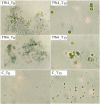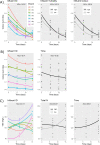Assessment of anammox, microalgae and white-rot fungi-based processes for the treatment of textile wastewater
- PMID: 33651835
- PMCID: PMC7924738
- DOI: 10.1371/journal.pone.0247452
Assessment of anammox, microalgae and white-rot fungi-based processes for the treatment of textile wastewater
Abstract
The treatability of seven wastewater samples generated by a textile digital printing industry was evaluated by employing 1) anammox-based processes for nitrogen removal 2) microalgae (Chlorella vulgaris) for nutrient uptake and biomass production 3) white-rot fungi (Pleurotus ostreatus and Phanerochaete chrysosporium) for decolorization and laccase activity. The biodegradative potential of each type of organism was determined in batch tests and correlated with the main characteristics of the textile wastewaters through statistical analyses. The maximum specific anammox activity ranged between 0.1 and 0.2 g N g VSS-1 d-1 depending on the sample of wastewater; the photosynthetic efficiency of the microalgae decreased up to 50% during the first 24 hours of contact with the textile wastewaters, but it improved from then on; Pleurotus ostreatus synthetized laccases and removed between 20-62% of the colour after 14 days, while the enzymatic activity of Phanerochaete chrysosporium was inhibited. Overall, the findings suggest that all microbes have great potential for the treatment and valorisation of textile wastewater after tailored adaptation phases. Yet, the depurative efficiency can be probably enhanced by combining the different processes in sequence.
Conflict of interest statement
The involvement of the companies in our study does not alter our adherence to PLOS ONE policies on sharing data and materials.
Figures





References
-
- European Commission. No Title. In: 2020 [Internet]. Available: https://ec.europa.eu/growth/sectors/fashion/textiles-clothing_en.
-
- Tippett BG. The Future of Textile Printing… Will be Digital. Int Conf Digit Print Technol. 2001; 418–422.
-
- Gupta S. Inkjet printing—A revolutionary ecofriendly technique for textile printing. Indian J Fibre Text Res. 2001;26: 156–161.
Publication types
MeSH terms
Substances
LinkOut - more resources
Full Text Sources
Other Literature Sources

